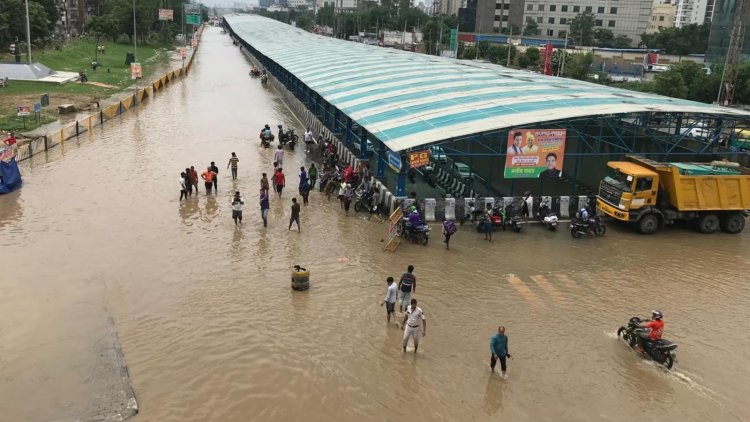Delhi crosses annual rain mark, Gurugram flooded again amid downpour
The city passed this threshold even sooner in 2021, when it got 780.1mmof rain by August 1, and 1,526.8mm of rain all year.

With over four and a half months left in the year, Delhi surpassed its annual rainfall quota on Saturday, after a severe spell of rain across the city and the National Capital Region (NCR) inundated streets and caused traffic chaos, particularly in Gurugram.
According to data from the India Meteorological Department (IMD), the Safdarjung station, which represents the city's weather, has received 775.8mm rain this year, exceeding the annual average of 774.4mm, with 12 days remaining in August — the city's wettest month — and more than a third of the year still to come.
The city exceeded this barrier even sooner in 2021, when it received 780.1mm of rain by August 1 and 1,526.8mm of rain for the entire year. Delhi received 811.4mm of rain last year.
READ ALSO : Woman stuck in Hawai wildfires loses Rs 2 lakh in online scam while trying to prepone her flight
To be sure, the city receives the majority of its rainfall during the monsoon months of June, July, and August. The final four months of the year receive only 152.6mm of rain.
Nonetheless, showers on Saturday morning caught commuters off guard and drenched various districts of the Capital, with waterlogging reported in Najafgarh, Punjabi Bagh, and neighbourhoods along the Outer Ring Road.
"I almost missed my flight in the morning because traffic was very slow due to the rains," said Shivam Chouhan, a Patparganj resident. This was aggravated by individuals taking shelter under flyovers in various locations, impeding other motorists.
Traffic policemen stated that they sent out real-time alerts to commuters in a number of regions, as well as stationed extra employees to help keep traffic moving.
"We deployed more personnel around the Outer Ring Road and at the Delhi-Gurugram border, but traffic was light because it was a weekend." "Flooding cleared out quickly in most of the waterlogged areas," stated a traffic official.
Authorities in Delhi had been on high alert for weeks after the Yamuna's floods reached record levels in July, prompting the administration to evacuate thousands of residents living on the river's floodplains and disrupting city life for days.
Even while officials blamed the river's rising levels — which crested at 208.66m on July 13, exceeding the danger mark of 207.33m — for the flooding, experts argued the city's antiquated sewerage system and lack of a competent drainage master plan had further exacerbated the Capital's woes.
However, Gurugram suffered the brunt of the rain once again, with swaths of Millennium City flooding on Saturday, stranding commuters on the road for many hours in bumper-to-bumper gridlock.
Gurugram experienced 62mm of rain in the 24 hours leading up to 5.30pm on Saturday, according to the weather service.
The heavily used NH-48 was the hardest hit, but few neighbourhoods were spared in what has been a recurring issue for the city for years.
The continual rain mess has been blamed on Gurugram's faulty drainage network, unplanned developments, and ever-mushrooming traffic, according to experts and residents.
The Narsinghpur stretch of the Delhi-Gurgaon Motorway, areas near the Iffco Chowk Metro station, and neighbourhoods in and around Hero Honda Chowk, Rajiv Chowk, Vatika Chowk, Iffco Chowk, Kherki Daula, Golf Course Extension Road, Southern Peripheral Road, Udyog Vihar, Sohna Road, Basai, Khandsa Road, and Pataudi Road were all affected.
Except for February, Delhi has reported rain in every month this year, and the actual rainfall has been more than typical in all of these months.
The city had 20.4mm of rain in January, compared to a normal of 19.1mm. In March, Delhi received 53.2mm of rain, compared to the average 17.4mm. This figure dropped to 20.1mm in April (when the typical is 16.3mm), then climbed to 111mm in May (30.7mm), 101.7mm in June (74.1mm), and 384.6mm in July (209.7mm).
The Capital has received 84.8mm of rain so far this month.
The IMD forecasted mild rain for the city in the coming days.
Generally cloudy skies with light rain or drizzle may be seen until Tuesday, with thundershowers possible." "The days will remain hot," the agency said on Saturday.
Despite the showers, it was hotter than usual in Delhi on Saturday.
The maximum temperature was 37.4 degrees Celsius (°C), four degrees above normal, while the minimum temperature was 28.2 degrees Celsius (°C), two degrees above normal.













